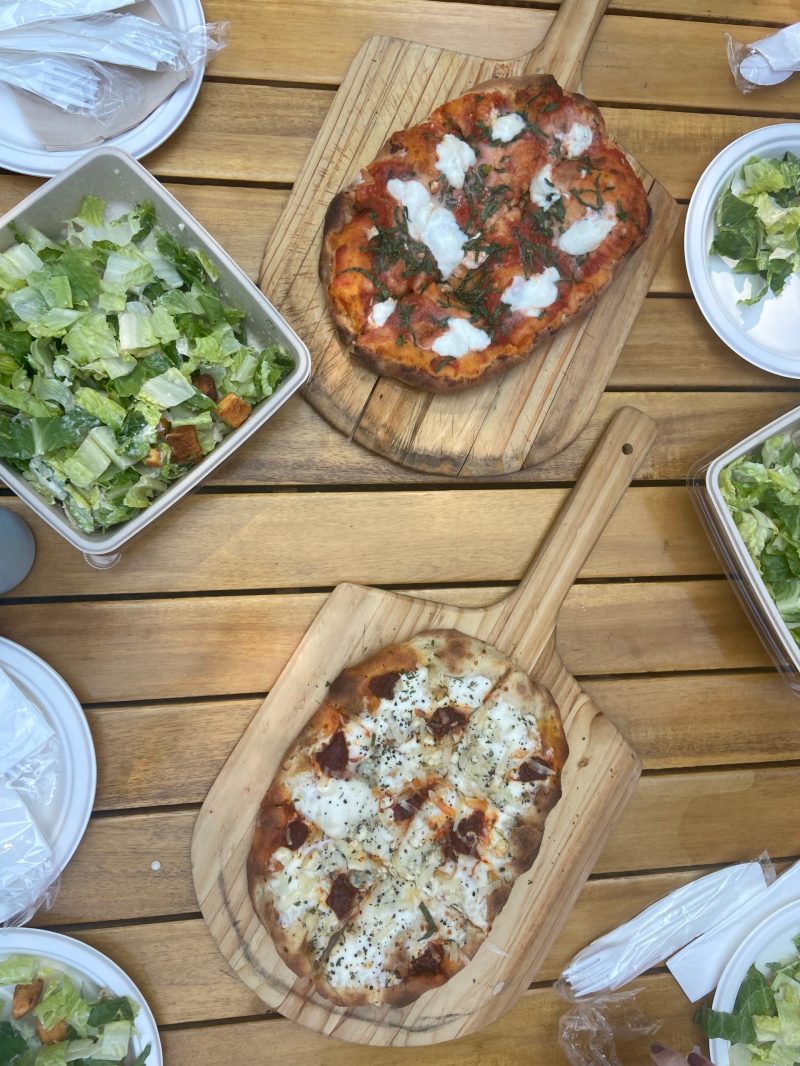The bottom crust snaps as the top of my teeth sink into mozzarella, calabrese, salty black olive and aromatic basil. The dough is light but still strong enough to hold its host of toppings. I can’t help but feel surprised; this delicious lunch feels like it belongs in the Italian countryside, not at Stanford’s Treehouse.
Meet the pinsa (pronounced “peen-sa”), a Roman-style pizza with extra-hydrated dough. Since reopening after the COVID-19 pandemic, Treehouse has pivoted to serve New York-style pizza and Roman-style pinsa in lieu of its rectangular Detroit and Chicago hybrid pies. The rest of the menu remains intact, and the range of classics from chicken tikka masala burritos to garlic parmesan fries is as delicious as ever. The pizza shift stems from hiring a chef, Naim Sit, from the legendary Gusto Pinseria on Bush street in San Francisco, according to Ray Klein.
Klein is the owner and manager of three campus staples: Treehouse, CoHo and Ray’s. Klein is a restaurateur who has had his hand in the California food scene for several decades. He was an early supporter of San Francisco favorite Tartine Bakery, which he helped move from Mill Valley to the city. Tartine is now a well-established bakery with multiple locations known for their breads and baked goods; I highly recommend their morning bun. Klein tried pinsa for the first time at Montesacro and then again at Gusto Pinseria several years ago. Since then, he has become a pinsa fanatic, and he jumped at the chance to recruit Sit to campus.
So what makes pinsa different? Pinsa dough has a higher water content than most bread and takes three days to mature. This process causes the complex sugars in the bread to break down into simpler glucose molecules, making the dough more digestible. The Gusto chefs add a San Francisco touch to their dough by incorporating dried sourdough to create a more dynamic texture and taste.
What sets pinsa apart for me is largely the crust, which manages to be fluffy and chewy while still maintaining a crunchy outer layer. The consumer is left with a delicious, rectangular pie paired with high-quality toppings and wonderful texture. The red sauces spread over the base are a tangy, bright complement to the salty mozzarellas sprinkled on top.
Treehouse currently offers six flavors of pinsa: margherita, bufula, funghi, diavola, quattro formaggi and pepperoni. The margherita is a classic — just tomatoes and cheese — and the bufula uses the same base with fresh bufula mozzarella, a fresh cheese only produced in certain regions of Italy that is hard to find on California menus. The funghi has sliced garlic-roasted mushrooms on top of the margherita base. The diavola has red sauce, mozzarella cheese with huge folded layers of spicy salami, olives, bell peppers, onions and a heavy hand of herbs. The quattro formaggi is topped with gorgonzola, mozzarella, aged cheddar and padano cheeses with spicy n’duja sausage. The pepperoni is another classic with red sauce, cheese and cured meat cups. I highly recommend the diavola for meat eaters and bufula for vegetarians. For a vegan option, it is possible to order a bare pinsa to accompany any meal.
The pinsa is a little on the pricier side. Each pie costs between 14 to 18 dollars. This is slightly above average for Treehouse and could deter some eaters. If you have the means, I strongly encourage trying it at least once. The pinsa tastes notably different, and isn’t close to anything else you can find around campus.
All around, the pinsa is a win for the Stanford dining scene. These cheesy delights are wonderful to share with friends at the Arbor for Thursday trivia night or to enjoy as an indulgent lunch.
Editor’s Note: This article is a review and includes subjective opinions, thoughts and critiques.
